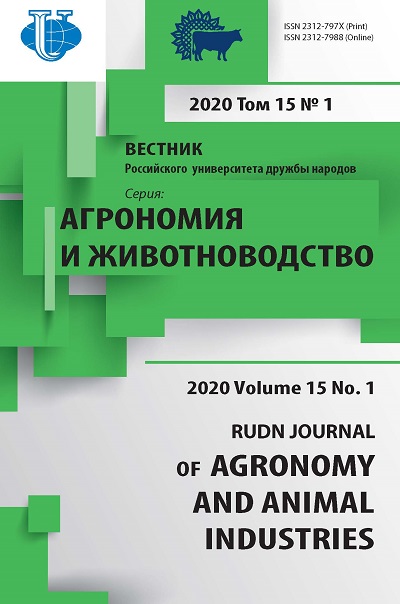Evaluation of new rice genotypes of Kuban breeding in conditions of environmental testing in the Republic of Adygea
- Authors: Dzhamirze R.R.1, Ostapenko N.V.1, Chinchenko N.N.1
-
Affiliations:
- Federal rice research center
- Issue: Vol 15, No 1 (2020)
- Pages: 86-96
- Section: Genetics and plant breeding
- URL: https://agrojournal.rudn.ru/agronomy/article/view/19545
- DOI: https://doi.org/10.22363/2312-797X-2020-15-1-86-96
- ID: 19545
Cite item
Full Text
Abstract
In solving the problems of modern rice growing associated with yield increase, resource/energy efficiency and profitability, development of new varieties and their timely introduction into production as a result of close cooperation of scientists and production workers is central. In this regard, the assortment of rice varieties of Kuban breeding is annually replenished with more productive ones having increased resistance to adverse biotic, abiotic and anthropogenic factors, technologization and energy supply during cultivation, and different cooking characteristics. Crop productivity is one of the main value indicators and the main requirement of production. It consists of number of plants per unit area and productivity of each of them. Therefore, in order to evaluate rice varieties and determine their suitability for cultivation in this agroclimatic zone, it is necessary to consider important agronomic traits and their variability during a certain time. The article presents the results of environmental testing of 20 rice varieties over three years (2016-2018). The variability of yield and number of productive stems per unit area in varieties was determined. The average and weak inter-varietal variability of productive plant stand (13.9; 10.3 and 13.5%) and yield (12.4; 9.2 and 9.9%) during the research period determines the optimal level of agricultural farming. The varieties that have formed a significantly high yield with its insignificant variability are recommended for cultivation in conditions of the Republic of Adygea.
Keywords
About the authors
Ruslan Ramazanovich Dzhamirze
Federal rice research center
Author for correspondence.
Email: dzhamirze01022010@yandex.ru
Candidate of Agricultural Sciences, senior researcher at the selection department
Krasnodar, Russian FederationNadezhda Vasilievna Ostapenko
Federal rice research center
Email: ostapenko30071954@yandex.ru
Candidate of Agricultural Sciences, Leading Researcher, Breeding Department
Krasnodar, Russian FederationNatalya Nikolaevna Chinchenko
Federal rice research center
Email: chinchenko1969@yandex.ru
postgraduate student, Selection Department
Krasnodar, Russian FederationReferences
- Dzhamirze RR, Ostapenko NV. Interrelation between structural yield elements and technological indicators of wholegrain and milled rice in new rice cultivars. Proceedings on applied botany, genetics and breeding. 2019; 180(3):26–31. doi: 10.30901/2227–8834–2019–3–26–31
- Dzhamirze RR, Ostapenko NV. Correlation of traits and their variability in rice breeding. Proceedings of the Kuban State Agrarian University. 2018; (74):25–32. doi: 10.21515/1999–1703–74–25–32
- Lapshinov NA, Pakul VN. Original seed breeding should be supported by the efficient technology. Zashchita i karantin rastenii. 2010; (8):21–23.
- Moiseev VV. On the issue of increasing the economic effi of growing grain crops in Krasnodar region through the development of breeding and seed production. Regional economics: theory and practice. 2007; (7):139–144.
- Dzhamirze RR, Ostapenko NV, Chinchenko NN, Filimonova ME. Breeding of large grain rice varieties. In: New and unconventional plants and prospects for their use. Proceedings of the XII International Symposium. Moscow: RUDN University Publ.; 2017. p. 180–182.
- Malysheva NN, Malysheva NN, Garkusha SA. Aspects of development of rice growing industry. In: New trends in the development of agricultural sciences. Collection of scientific papers following the results of the IV international scientific-practical conference. Rostov-on-Don: Innovation Center for Development of Education and Science; 2017. p. 18–21.
- Esaulova LV, Garkush SV, Kizinek SV. Scientific priorities of adaptive intensification of rice production in Russian Federation. In: Scientific priorities of adaptive intensification of agricultural production. Proceedings of the international scientific-practical conference with elements of young scientists. Krasnodar: VNII risa Publ.; 2019. p. 34–36.
- Lysenko YA, Chuev IN, Khrisonidi VA. Problems and prospects of rice cultivation on the example of Krasnodar region and the Republic of Adygea. Fundamental Research. 2019; (4):66–70.
- Information about the spring field agricultural works in the 06.05.2019. In: Republic of Adygea. Official website of Executive bodies of state power. Available from: http://www.adygheya.ru/ministers/departments/ ministerstvo-selskogo-khozyaystva/novosti-ministerstva/informatsiya-o-provedenii-vesennikh-polevykhselskokhozyaystvennykh-rabot-na-06–05–2019-goda/ [Accessed 21th November 2019].
- Kharitonov EM, Skazhennik MS. Climatic and physiological aspects of rice yield formation in Krasnodar region. Rice growing. 2014; (2):6–12.
- Dospekhov BA. Metodika polevogo opyta [Methodic of fi d experiment]. Moscow: Kolos Publ.; 1979.
- Dzyuba VA. Mnogofaktornye opyty i metody biometricheskogo analiza eksperimental’nykh dannykh [Multifactorial experiments and methods of biometric analysis of experimental data]. Krasnodar; 2007.
- Sheudzhen AK, Bondareva TN. Metodika agrokhimicheskikh issledovanii i statisticheskaya otsenka ikh rezul’tatov [Methods of agrochemical research and statistical evaluation of their results]. Maykop: Polygraph-Yug Publ.; 2015.
- Vorobyov NV, Skazhennik MA, Kovalyov VS, Pshenitsyna TS, Motornaja OJ. Features of production process of rice varieties determining their yield. Rice growing. 2015; (3–4):6–12.
Supplementary files















